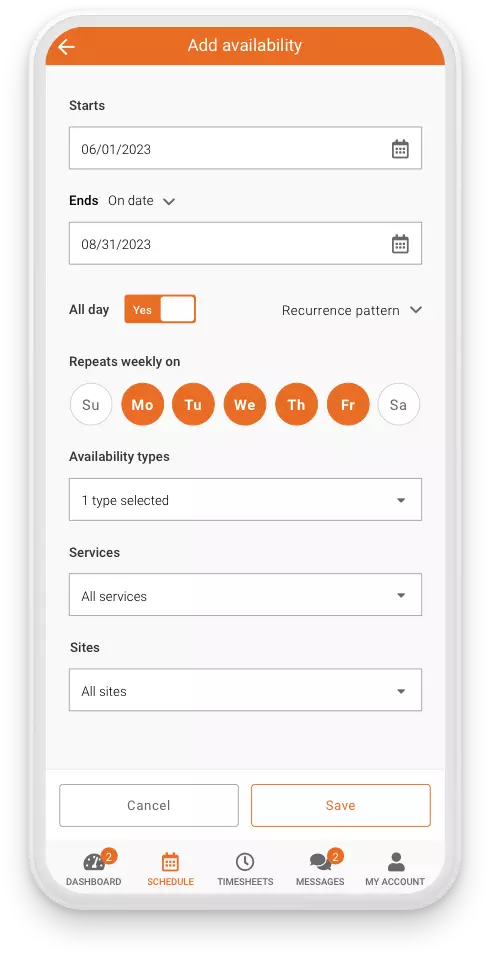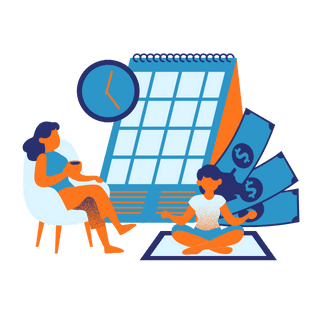Have you heard of a 24 hour shift schedule? Yes, they do exist! You may be wondering if there’s any demand for such a job, right? It turns out there are various industries that have continuous operations and hence work on a 24 hour shift schedule.
Nevertheless, it doesn’t always require that an employee work a full 24 hour shift schedule. So how does it work?

About 25% of the US population are shift workers. Within that, we can assume a good chunk of them work in 24 hour industries. A 24 hour shift schedule is particularly common in healthcare, hospitality and national services. However, more jobs by the year are becoming such that employers must schedule their employees on a 24 hour shift schedule. Oh, and we also offer 24/7 email customer support—no big deal, just in case you need us at 3 a.m. or something.
Employers can create schedules in various ways based on the number of employees they have. Unfortunately, there is no one-size-fits-all solution when it comes to staff scheduling. But this allows employers and employees to take advantage of employee scheduling software and work the shifts they want. In this blog, we will discuss a 24-hour work schedule and how employers can create the best schedule for their staff.
What is a 24 hour shift schedule?
You’ve heard people say they’re working full-time but have you heard anyone say they’re working a full day? Most say it metaphorically, but few employees literally have to work the entire day! A 24 hour shift schedule may now sound daunting to you, right? Of course, that’s not always the case, especially when employers have to choose from a pool of employees.
A 24 hour shift schedule is a schedule that employers create for jobs that require continuous operations. Since workers experience decreasing satisfaction with each additional hour worked, employers should create a schedule that employees are happy to follow. This means dividing the day into rotating shifts or having a particular employee work the entire day. Again, the options are limitless, yet employers must find the schedule that best fits employees’ needs.
When building a 24 hour shift schedule, it’s crucial to identify the main goals, for example:
- Maximize Employee Health
- Maximize Fairness
- Minimize Operation Costs and Risks
- Minimize Scheduling Effort
Once these goals are identified, you can start building your 24-hour shift schedule!
Building a 24 hour shift schedule
These are the questions you should keep in mind when building a 24 hour shift schedule;
- What factors to keep in mind before building your 24 hour shift schedule?
- How to develop your workforce and assign shifts to them for a 24 hour shift schedule?
- What are the potential impacts of using a rotating shift vs a 24 hour fixed work schedule for an employee?
- How is employer participation in scheduling so crucial for a 24 hour shift schedule?
Factors to keep in mind
Because 24 hours is a significant amount of time to work with, there are numerous approaches to constructing the shift schedule. There’s no correct or incorrect method; it depends on what works best for your team. We’ve compiled a list of the most critical variables to consider when deciding the best shift plan for your team.
What kind of business do you run?
An employee’s demands and management expectations are vastly different in restaurants, hospitals and the manufacturing industry. The questions you ask to determine the ideal 24-hour shift plan may differ.
- A hospital may inquire about the seasonal patient census and weekend crises.
- A manufacturing plant must deal with production demands, regular maintenance, and equipment shutdown.
- A restaurant’s main issue is client traffic.
- In contrast to many other types of businesses, a security company may require additional staff on hand during low-traffic hours.
What type of availability does your team have?

How many workers do you have? What is the availability of each?
Depending on their circumstances, some of your employees may be able to offer you more hours than others. Instead of presuming that everyone is the same, talk to employees. Inquire about their availability.
Some of the 24 hour shift schedules available are better suited for larger personnel groups; those are out of the question if you have a small team.
What do your sales figures tell you?
You must understand your client’s traffic patterns when creating your 24 hour shift schedule.
When are you most busy? When does it get slow? What kinds of client needs arise at various periods of the day? Do you provide delivery services?
For example, if you own a 24 hour restaurant, perhaps your late-night clients prefer coffee and pie, and you may be able to switch off the grill, not book kitchen workers, and only provide essential counter services for those late-night shifts instead. Perhaps you will only offer delivery services during busy hours. Sales forecasting can help identify how much labour demand is required at different hours.
What business resources do you provide?
Can you afford to work extra hours? Can you pay more for folks who work the night shift or less attractive shifts?
It’s a good idea to have these figures on hand before deciding on a 24 hour shift schedule because you may need incentives to fill out some of those late shifts. Offering an extra salary if you can’t afford it is a bad idea, so know your options ahead of time.
What do your workers prefer?
Working at any time of day or night may raise worries and strong preferences among your staff.
What are your employees looking for? Can you solicit their feedback and involve them in the schedule, so they feel they have control over it? Do they want shifts to be rotated? Are they looking for 8-hour or 5-hour shifts?
Ask your team if you don’t have legislation requiring 8-hour shifts.
While it may appear more manageable and faster to decide on your own, it will significantly influence your employees’ personal lives. Obtaining their opinion is not only the wise thing to do but also the moral thing to do.
What level of flexibility will you provide?
Flexible self-scheduling is common for shift work, but it requires planning when working a 24-hour shift schedule.
Will you allow employees to swap shifts and schedules with one another? If so, how will you manage it such that you have adequate coverage for each shift? Not just in terms of the number of employees but also in terms of requisite skills. How will you ensure that staff take shifts that will not result in burnout or sleep problems later on?
You should use scheduling systems that allow you to create constraints and rules so that, even if employees can swap shifts with each other, they do so within your policies.
What role will Paid Time Off play?

What role does employee-paid time off play in your schedule?
Any time off, including calling in sick, can disrupt your schedule. While you can plan paid time off with your employee, it will still leave a void in your team. If you arrange a 24 hour shift schedule that takes advantage of every employee, the absence of even one will put you in a dilemma.
What practices should you avoid?
Many supervisors struggling to fill their schedules will be tempted to assign a clopening shift. Please don’t do it. The clopening shift is the previous night’s closing shift, followed by the next morning’s opening shift, and it’s hard on personnel.
Yes, you are a 24 hour business; however, some places that claim to be 24 hour have a closing routine before they gear up for the new day, and some close down for a brief time in the early morning to clean and reset.
Even if you have a true 24 hour operation, scheduling someone to work the evening and early morning shifts while someone else handles the midnight shift is a bad idea. Employees will suffer from sleep deprivation, poor mental and physical health, and general burnout if you adopt clopening shifts.
No employee’s schedule should include a late night/early morning back-to-back shift, even if they swear they don’t mind.
Common types of 24-hour shift schedule coverages
Shifts can be arranged differently during a week and even across a day. You won’t be able to consider all 500 distinct 24/7 shift scheduling patterns, so limit that list by identifying the numerous shift elements unique to your company. Think about the following:
- Weekly 24-hour coverage requirements
- Number of employees
- Desirable Shift Length
- Time-off requirements
Once you have thought of these, you can decide which of the following type of shift schedules works best for your organization.
Fixed shifts
The most convenient option is to hire people for specific shifts. That means they’ll always work the same shift with no surprises. Shifts are employed based on client demand during particular shifts. Part-time workers can cover the hole in businesses where clients spike during part of a shift.
This makes scheduling easy, and some employees prefer it because their bodies don’t have to constantly readjust to changing day and night shifts. Customers become accustomed to dealing with the same staff when they visit at the exact times of the day.
Employees who do not enjoy their current shifts will not be allowed to work on another. They may seek employment elsewhere. Fixed shifts are appropriate for any size firm, but keep in mind that employees require time off. More staff are required than the bare minimum to cover all shifts and account for those who take time off.
Rotating Shifts

Rotating shifts are more equal since they allow employees to work all shifts. Nobody gets all of the “good” shifts, and nobody gets all of the “poor” shifts.
Rotating shifts can be:
- Constant: The shifts are rotated over a short period (e.g. week). This can be physically and mentally taxing on staff.
- Slow: Shifts are rotated considerably more slowly, often over months, to allow staff to adjust to the shift.
- Weekend: Employees rotate working weekend shifts, which is frequent in smaller organizations that don’t have enough staff to cover it otherwise.
- Partial: Some staff have set shifts, while others alternate.
Rotating shifts perform well in medium and big businesses, especially when the types of rotations are mixed.
Swing shifts
Swing shifts, common in enterprises requiring consistent production or coverage, allow for variable starting and stopping locations for employees each day rather than a predetermined start-stop for every employee in a shift.
Instead of shifts like 8-4, 4-12, and 12-8, there would be shifts like 9-5, 11-7, and so on mixed in.
They can be used with typically fixed shifts so that someone is always available to carry over from one shift to the next for easier transitions. Some employees enjoy the challenge of swing shifts because it keeps them from being bored with the same shifts and hours. Others want consistent shifts that they can schedule their calendar around.
Because of the number of staggered shifts, swing shifts necessitate a more significant personnel base, making scheduling more difficult. However, scheduling software such as Celayix can certainly help ease this burden.
Days on, days off, plus shift rotation

Combining shift rotation with how you plan your work week will solve many equity issues. Consider this 24/7 shift plan, which might be divided into:
Five days on and two days off.
- An employee works five days and then has two days off, with the day divided into three shifts of eight hours each (day shift, middle shift, and night shift). The schedule shifts the following week, so their two days off are offset by one day. The timetable would return to where it began every seven weeks.
- Because it’s not a good idea to switch an employee between day and night shifts too frequently (it affects sleep habits), you may give an employee the day shift for seven weeks, the middle shift for seven weeks, and the night shift for seven weeks. You could break it up if staff don’t want to work seven consecutive weeks on one shift.
- This strategy is effective with a staff of 15 or more (to ensure coverage in all rotations).
Alternatives
Alternatives include four days on, two days off (for groups of 36 or more employees), five days on, three days off (for groups of 40 or more), and so on.
Every employee has two moving parts: the week they are on and the shift they are on. Managing these alternating weekly and shift plans is best accomplished with an employee scheduling tool that supports templates.
This method is fair since everyone gets a chance to work the desirable and unattractive days and shifts. It also provides them with consecutive days off to rest. However, this technique may not be as effective if your firm requires specific skill sets on certain shifts.
As you can see, 24-hour scheduling may be difficult. It’s no longer about the days of the week someone works but also the times of those days. Identifying ways to keep this sort of shift schedule healthy for the employees and sustainable for the organization is essential. There is always the risk of employee burnout that you need to keep in mind!
A shift template is the best way to go, but an organization would only feel the advantages if they were easily accessible to the entire workforce. Celayix can directly provide you with this opportunity.
A single shift requires a lot of actual blood, sweat, and tears. So, you have our undying gratitude if you work 24-hour shifts regularly! These transitions tend to go south, but that doesn’t have to be the case every time.





